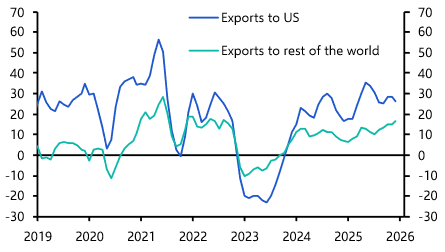While US readers were settling in for Thanksgiving dinners, those of us on the other side of the pond were left to pick over the remains of a Brexit deal that looks dead on arrival.
Our UK economists have covered the various twists and turns in detail and copies of the various publications are available to clients in the usual place on our website. The story so far is one of abject political failure on pretty much every side in the UK – the government has failed to sell its deal to a fractured parliament, Brexiteers within the Tory party have failed to either depose the Prime Minister or propose an alternative Brexit plan, and the opposition Labour Party has tried to be all things to all people and in the process failed at its core job of holding the government to account.
The UK economy, in contrast, has fared rather better. That’s not to say that Brexit has had no effect at all – by our estimates the economy is about 1.0% smaller than it would have been had we voted to remain. (The loss of output stems from a squeeze on consumer spending following the initial fall in the pound and, more recently, a drag on business investment as firms have delayed spending decisions until the post-Brexit landscape becomes clearer.) But the predictions of a deep and prolonged recession that were made by many in the initial aftermath of the vote (though not us) were clearly wrong.
So what next? The fact that, with just four months to go until the UK is due to leave the EU, there are at least five different ways in which Brexit could unfold, tells its own sorry story. (See Chart.) Note too that these are just the permutations with regard to Brexit – on top of this, there is the possibility (albeit now diminishing) that PM May is ousted by her own party or that her coalition government collapses and parliament votes for an early general election.
Chart 1: What next for Brexit?

As things stand, it seems unlikely that the deal that was signed off by European leaders this weekend will be approved by the UK’s parliament. A vote seems likely at some point in the week beginning December 10th. If the government loses, it would probably set the stage for several weeks of further negotiation, with officials and ministers scurrying between London and Brussels trying to revive the deal. If that then fails, we’re left with a choice between “fudge and delay” – any of the options towards the right of Chart 1 that, to varying extents, maintain the status quo for the time being – or a “no deal” Brexit.
Plenty of ink has been spilt on the latter, but a key point that is often overlooked is that there are many different forms of “no deal”. At one end of the spectrum, is an “orderly” or “managed” no deal, in which the UK leaves the EU without a Withdrawal Agreement, but does have several side agreements in place that keep traffic flowing at ports and airports and limit the risks of financial market dislocation. At the other end of the spectrum, is a “disorderly” no deal in which no such agreements are struck.
We looked at the economic consequences in each case in a piece published earlier this year. Three points stand out. First, while there would be a short-term hit to the economy in both scenarios, it would be substantially smaller in the event of an “orderly” no deal than it would be in a “disorderly” one – in the former we think GDP might initially fall by around 1% relative to our baseline, while in the latter it might drop by around 3%.
Second, in both cases the disruption is likely to be temporary and we suspect the economy would return to growth by the second half of 2019. This would be helped by policy support – despite hints to the contrary from the Governor Carney, our sense is that the BoE would cut interest rates in the event of a no deal downturn, and we think the Chancellor would tear up his budget rules and loosen fiscal policy too. (The market implications are summarised here.)
Finally, despite this recovery, we think that in both scenarios the economy would still be smaller than would otherwise be the case by the end of 2020. (See Chart 2.) That being said, depending on the types of trade deals that a subsequent government was able to secure, we wouldn’t rule out the possibility that the economy recovers all of the lost output by the early part of the next decade and that trend growth thereafter is broadly unchanged from its current rates of just under 2%.
Chart 2: UK Real GDP (Q1 2017 = 100)

Stepping back, then, what emerges from all of this is a five-year economic and financial market rollercoaster – all of which leaves the UK populace with little to be thankful for.
In case you missed it:
(Requires login)
- Our China team has published its latest China Activity Proxy, which is our estimate of the true pace of economic growth in the country.
- Our Global Economist, Simon McAdam, takes a closer look at the risks posed by leveraged loans.
- Our EM team explains why a weaker currency seems to be helping Turkey but not Argentina.




